- Home
- Richard Adams
The Day Gone By
The Day Gone By Read online
THE DAY GONE BY
Also by Richard Adams
Watership Down
Shardik
The Plague Dogs
The Girl in a Swing
The Iron Wolf and Other Stories
Maia
Traveller
Travel
Voyage Through the Antarctic (with R. M. Lockley)
Picture books in verse
The Tyger Voyage
The Ship’s Cat
Nature
Nature Through the Seasons
Nature Day and Night (both with Max Hooper)
A Nature Diary
RICHARD ADAMS
AN AUTOBIOGRAPHY
THE DAY GONE BY
© 2014 Richard Adams
Richard Adams has asserted his rights in accordance with the Copyright, Designs and Patents Act 1988 to be identified as the author of this work.
Published by Watership Down Enterprises
First published and printed in 1990
First published in eBook format in 2014
ISBN: 978-1-78301-570-2
All rights reserved under International and Pan-American Copyright Conventions. By payment of the required fees, you have been granted the non-exclusive, non-transferable right to access and read the text of this e-book on-screen. No part of this text may be reproduced, transmitted, downloaded, decompiled, reverse-engineered, or stored in or introduced into any information storage and retrieval system, in any form or by any means, whether electronic or mechanical, now known or hereinafter invented, without the express written permission of the Publisher.
All names, characters, places, organisations, businesses and events are either the product of the author’s imagination or are used fictitiously. Any resemblance to actual persons, living or dead, is purely coincidental.
eBook Conversion by www.ebookpartnership.com
To my grand-daughters, Lucy Johnson and Sarah Mahony with love and best wishes for the years to come.
Contents
List of illustrations
Acknowledgements
All That’s Past
Chapter I
Chapter II
Chapter III
Chapter IV
Chapter V
Chapter VI
Chapter VII
Chapter VIII
Chapter IX
Chapter X
Chapter XI
Chapter XII
Chapter XIII
Chapter XIV
Chapter XV
Chapter XVI
Chapter XVII
Chapter XVIII
Chapter XIX
Chapter XX
Chapter XXI
Chapter XXII
List of illustrations
Letter home of 21 July 1929
South-West Oxford in 1939
Punch cartoon of 30 July 1924
Plan of Operation ‘Market Garden’
C Platoon, 250 Light Company R.A.S.C.(Airborne) in 1944
Acknowledgements
I am grateful to Miss A. Page, of the Oxford City Surveyor’s department, who kindly supplied me with the map of old St Ebbe’s which appears on page 219.
I am much indebted to Geoffrey Powell, formerly of Airborne Forces and author of The Devil’s Birthday: The Bridges to Arnhem, for checking the accuracy of the chapters about Operation ‘Market Garden’ and making valuable comments: and also for kindly giving consent for the reproduction of the map of the plan for Operation ‘Market Garden’ on page 338.
I am most grateful to Richard and Hailz-Emily Osborne, of Bradfield, who gave invaluable help over the Bradfield photographs, and to Jimmy Stow, who was equally helpful over Horris Hill.
I thank warmly my secretary, Mrs Elizabeth Aydon, who not only typed the book most accurately and conscientiously, but also picked up for me those slips and inconsistencies to which most, if not all, authors are prone.
All That’s Past
VERY old are the woods;
And the buds that break
Out of the brier’s boughs,
When March winds wake,
So old with their beauty are—
Oh, no man knows
Through what wild centuries
Roves back the rose.
Very old are the brooks;
And the rills that rise
Where snow sleeps cold beneath
The azure skies
Sing such a history
Of come and gone,
Their every drop is as wise
As Solomon.
Very old are we men;
Our dreams are tales
Told in dim Eden
By Eve’s nightingales;
We wake and whisper awhile,
But, the day gone by,
Silence and sleep like fields
Of amaranth lie.
Walter de la Mare
Chapter I
My paternal grandfather, Joseph Dixon Adams, was born in 1837 - the year of Queen Victoria’s accession. There is a story in the family that one night in 1854 he was awakened by the stir in the village caused by a horseman bringing news of the great British victory of the Alma, in the Crimea. The village was Martock, in Somerset, lying between Taunton and Yeovil.
People were poor enough in those days: the labourers lived largely on beans, and there was a saying that if you could shake a Martock man you could hear the beans rattle: if you could shake him. A few Martock men, poor devils, were caught up in Monmouth’s rebellion of 1685 and duly appeared before Judge Jeffreys in the Bloody Assize. Martock has a beautiful church, with a magnificent interior roof. On the south wall, going on towards the east end, is a brass plaque in memory of my grandfather, extolling inter alia his running of the local fire brigade. They must all have been part-time volunteers, for my grandfather was not a fire officer but a doctor - a Victorian country doctor who paid visits on horseback and made up his own prescriptions. I have two of his pharmaceutical white-earthenware, lidded jars, each about ten inches high, handsomely decorated in blue and gold. One is lettered ‘Tamarinds’ and the other ‘Honey’. (Tamarind pods were used as a laxative and also for ‘allaying fever’; honey was for coughs.) There would have been a third jar for leeches, but this I have never seen.
In his maturity Joseph was well-to-do, with social standing in the locality and a fine house and garden (it’s still there) called ‘The Lawn’. A lot must have been due to his wealthy marriage. At some time during the eighteen-sixties - and this is another family story - he rode alone to the county ball at Taunton, where he met and danced with Arabella, the daughter of Sir Cecil Beadon. Sir Cecil had recently retired as Lieutenant-Governor of Bengal. He was a grandson of Richard Beadon, Bishop of Bath and Wells (in reply to whom Hannah More wrote her famous letter defending Sunday schools. The latitudinarian bishop, who didn’t like the notion of educating the poor, had told her to lay off, but she was up to him). Cecil, who was born in 1816, joined the Bengal civil service (through nepotism, of course) in 1836. He came to the notice of Lord Dalhousie and had an eminently successful career until about the last five years of his service, when - largely due to ill health - as lieutenant-governor he came badly unstuck over his handling of— or failure to handle - the terrible Orissa famine. A commission of inquiry reported unfavourably on him; the Governor-General, Sir John Lawrence, saw no reason to take a different view and Cecil, albeit with a knighthood of the Star of India, retired in 1866, with plenty of money but his brilliant reputation overshadowed. He was twice married. His first wife, Arabella’s mother, was born Harriet Sneyd, daughter of a major in the Bengal cavalry.
Joseph Adams married Arabella Beadon, and George, their eldest son and my father, was born in 1870. He, too, became a doctor (he ultimately became an F.R.C.S.)
, and was a student at Bart’s during the ‘nineties. Then he returned to Martock and went into partnership with his own father. To distinguish between the two, the villagers used to refer to my grandfather as ‘Dr Adams’ and my father as ‘Dr Jarge’. It must have been about 1962 when I last visited Martock, and in the church came upon a lady tidying and polishing. We chatted, and when I told her who my father had been she called her husband from the vestry, saying ‘Ben, this is Doctor Jarge’s son.’ ‘Well, I never!’ said he. ‘Doctor Jarge! I ’member ’im well - ’im and ’is motor-cars!’ (Long before the First World War, during the reign of Edward VII, my father had been one of the first ‘Toad of Toad Hall’ motorists, with a De Dion Bouton. My mother used to tell me how one day, when he was driving along a country lane, he saw, to his gratification, two farm-hands in a field throw down their hoes and run to the hedge to watch him go by. As he passed, one said to the other ‘Reckon that bloody fool won’t live long.’)
Joseph had three other children: Katharine (to whom my father was deeply attached), Ernest and Lilian. Ernest deserves a little notice here, both on account of his impulsive, extravagant, flamboyant character (which I believe to have been passed on to some extent to myself) and also because of his affinity with birds and animals, which amounted to a gift. As a medical student he was up to all manner of larks and used to play the banjo, with a black face, a straw hat, white trousers and scarlet blazer. He had a pet tawny owl which my father said used to blunder about, knocking ornaments off the mantelpiece and ‘shitting all over everything’. He had a marvellous dog, Esau, which he had trained himself. When Ernest took the ’bus from his digs to Bart’s in the mornings, Esau would keep pace along the pavement and rejoin him when he got off. People used to say that Esau could do everything but talk (though he would bark when told to).
Ernest, with his pranks, his animals and birds, his unpredictable capers and his extravagance, must, I think, have been something of a worry, if not an actual embarrassment, to my grandfather, who took his social position in the county very seriously. In later life he was a formidable man. Once, Katharine and Lilian were persuaded by their partners to stay out late after a dance. ‘That’s all right. We’ll see you home: we’ll explain to your father.’ When they got home all was dark, locked, bolted and barred. They had to ring and knock. At length, through the hall window, a candle was seen approaching, bolt after bolt was drawn and the heavy door slowly opened. There stood my grandfather in his nightshirt. Such was the sight that the two young men turned tail and fled into the night. Katharine and Lilian had to do their own explaining.
When Ernest reached his early thirties he went out to East Africa as a doctor. I suspect that he may have been given a bit of impulsion in that direction, though both his temperament and his love of nature would have made him nothing loath. He duly arrived in Nairobi and, as Shakespeare’s Beatrice puts it, set up his bills. Before long, however, reports began to reach home of wild expenditure. Ernest was giving elaborate parties. He had designed a gaudy uniform and clothed all his black servants in it. My grandfather became alarmed. Ernest was quite capable of landing the family with his debts. Besides, what were people going to say? My grandfather told my father that he would have to go out to Nairobi, read Ernest the Riot Act and straighten things out.
But before my father could sail, worse news came. Ernest was dead of black-water fever. I have always felt so sorry. I wish I had known him: I’m sure we would have got on well. I have often felt in myself his instability, his impetuosity, his irresponsible hilarity and his feeling for the country and for birds and animals.
When sorrows come, they come not single spies, but in battalions. Within a few months of the death of Ernest, his sister Katharine also died. A pet dog which she was fondling bit her in the face and blood-poisoning developed.
I don’t think my father ever really recovered from these bereavements. He was by nature a sensitive, reticent man, ‘not a good mixer’, as he himself used to say, and though he had a dry sense of humour, I never knew him actually to laugh or to show the least turn for glee or jollity. Anyway, cancelling the booking for Mombasa, he continued in practice with my grandfather. He was now nearly forty and still unmarried.
It was one day in 1909 that he decided that an old lady, a patient of his, would be the better for a resident nurse, and asked for one from the hospital at Bath. The girl they sent - who was aged about twenty-five - was a Miss Lilian Rosa Button, the second daughter of a not very well-off violinist in Bath. She had been brought up a Methodist. Socially, of course (and it must be remembered that this was 1909), she was entirely beneath my grandfather’s notice - the next thing to a housemaid and a good cut below a governess. But she was a pretty girl, vivacious and amusing, with plenty of common sense. My father, for the first time in his life, found himself in love. Her social inferiority was a great help, for it dissolved his natural shyness and diffidence. He could let her make the running and simply be what he was. They took to meeting secretly in the lanes, down the garden - anywhere they could.
When my father said he was going to marry Lilian Button there was a hell of a row. The Adamses and the Beadons didn’t half create. One fragment only my mother passed on to me. They said to her ‘We’ve got a Lilian already in the family, so we’re going to call you Rosie.’ If this doesn’t strike you as humiliating, reader, try it on yourself.
There were worse humiliations, I am fairly sure. However, there must have been a degree of acceptance, for I have two amusing recollections of my mother’s from about those times. Martock lies only a mile or so from Montacute, and the Adamses were, of course, on friendly terms with the Powys family, which included those three egregious authors, the brothers John Cowper, Llewelyn and T.F. Powys. There used to be visits to Montacute. My mother once told me how, while she was sitting on the terrace with one of the brothers - she didn’t say which one - he suddenly asked her ‘Doesn’t the intense beauty of that cloud give you a pain?’
‘Whatever did you say, Mummy?’
‘I said “No”.’ (She uttered it in a tone of perplexity mingled with the faintest touch of exasperation.) That apparently concluded the conversation.
At some other time during my childhood my mother remarked, a propos of nothing in particular, ‘That Mr Hardy wasn’t a very nice old man.’ I have often wondered since whether she might have met Florence (she could not have met Emma) and if so, what she thought of her.
Anyway, what happened was that my father married his Lilian (who abjured her Methodism and became C. of E.), told my grandfather that he had no wish to continue in practice with him and bought a practice at Newbury in Berkshire.
At first they lived in a distinctly modest, rather ugly house in a Pooteresque, unfashionable street. At Newbury Hospital my sister Katharine was born in 1911 and my brother John in 1913. In 1914 my father tried to enlist in the R.A.M.C., but they wouldn’t have him: by then he was forty-four. My brother Robert was born in 1916 and in 1919 died in the terrible influenza epidemic which swept Europe in the wake of the war. Thereafter my parents, sister and brother never spoke of Robert, and as a little boy I never even knew of his existence.
I was born in May 1920. I have sometimes wondered whether, if poor Robert had lived, I would have been born at all, for my father - who was usually up-to-date - knew all about Marie Stopes and possessed a copy of her book Married Love (which he kept locked up). This wasn’t the sort of question about which you could ever have asked my parents: but my conception must have been intended, I think.
In spite of his humble start my father had got on well in Newbury, both in the hospital and in the country round. One of his patients was the famous John Porter of Kingsclere, who had been racehorse trainer to Edward VII and trained Minoru and goodness knows how many more great winners. (My father once told me that at Christmas 1916, when virtually no luxuries whatever were to be obtained, John Porter sent him not a bottle, but a case of cherry brandy.) If my father was going to build up a good practice among weal
thy people (which he did), he needed a better house in a more distinguished neighbourhood.
Apart from the death of Robert, a year or two before my birth, two things happened. My grandfather died, aged about eighty, and my father bought the beautiful house out at Wash Common (then outside Newbury) where I was born. My mother told me an odd story about this: apparently my father came home one day and said to her ‘I don’t know what you’ll say, but I’ve gone and bought Miss Bruxner’s house.’ She told me this with pleasure and with no air of resentment whatever - it was, after all, a marvellous change for the better - yet it seems strange that apparently she herself didn’t get a look at the house or even hear of his intention before he bought it.
It certainly was a splendid place to grow up in. The house, ‘Oakdene’, had been built about 1895, in a style that was then rather popular with upper middle-class people in the south of England. It was L-shaped, with the long arm facing due south and the short, east. It was of brick, with a tile-floored, pilastered verandah running the whole south length. The upper storey (there were only two) was half-timbered against cream-coloured plastering. The tiled roofs were pitched. Downstairs was a parquet-floored hall, also running the length of the house, and off this opened at one end the dining-room (where we mostly lived), at the other the drawing-room (which was not sacrosanct, like some, but was also used a good deal, especially since it contained my brother’s piano); my father’s consulting-room and study; and the pantry, which led to the kitchen, scullery, larder and mangle-room. There were no fewer than seven bedrooms, two of them for servants. One of these became my nursery.
There were three acres of land altogether and a gardener’s cottage, which had its own small garden. The superb view to the south was across the open country of ploughland, meadows and copses typical of the Berkshire-Hampshire border, stretching away four or five miles to the distant line of the Hampshire Downs - the steep escarpment formed by Cottington’s Hill, Cannon Heath Down, Watership Down and Ladle Hill.

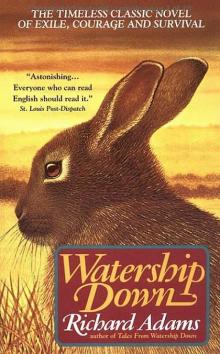 Watership Down
Watership Down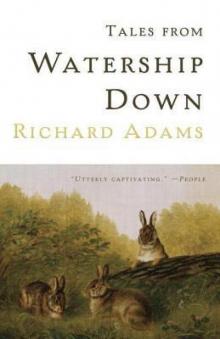 Tales From Watership Down
Tales From Watership Down Maia
Maia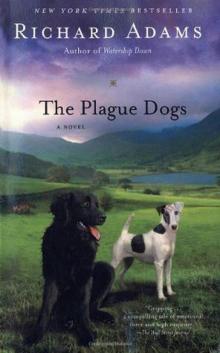 The Plague Dogs
The Plague Dogs Shardik
Shardik Traveller
Traveller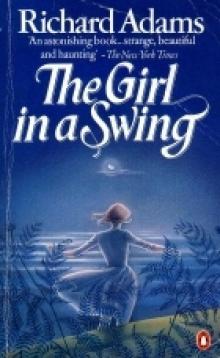 The Girl in a Swing
The Girl in a Swing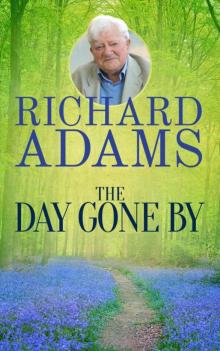 The Day Gone By
The Day Gone By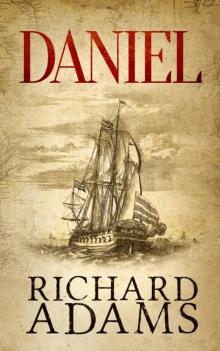 Daniel
Daniel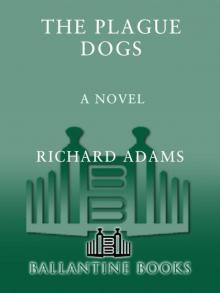 The Plague Dogs: A Novel
The Plague Dogs: A Novel